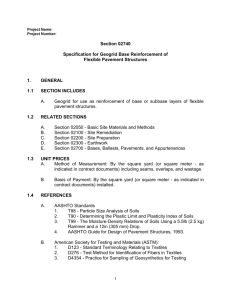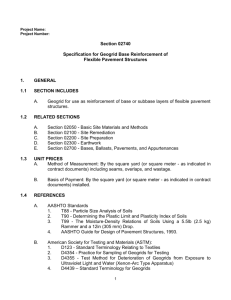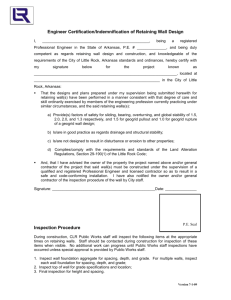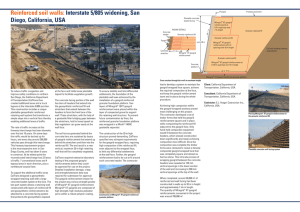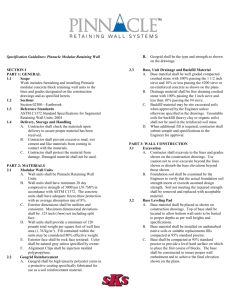************************************************************************** USACE / NAVFAC / AFCEC / NASA ...
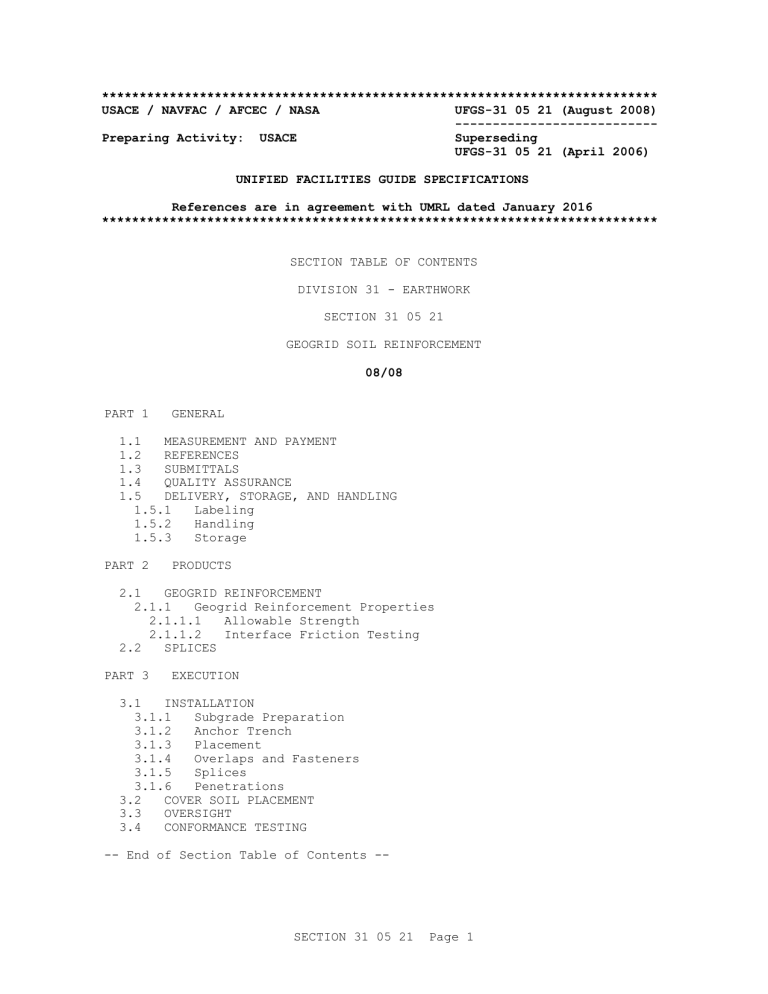
**************************************************************************
USACE / NAVFAC / AFCEC / NASA UFGS-31 05 21 (August 2008)
---------------------------
Preparing Activity: USACE Superseding
UFGS-31 05 21 (April 2006)
UNIFIED FACILITIES GUIDE SPECIFICATIONS
References are in agreement with UMRL dated January 2016
**************************************************************************
SECTION TABLE OF CONTENTS
DIVISION 31 - EARTHWORK
SECTION 31 05 21
GEOGRID SOIL REINFORCEMENT
08/08
PART 1 GENERAL
1.1 MEASUREMENT AND PAYMENT
1.2 REFERENCES
1.3 SUBMITTALS
1.4 QUALITY ASSURANCE
1.5 DELIVERY, STORAGE, AND HANDLING
1.5.1 Labeling
1.5.2 Handling
1.5.3 Storage
PART 2 PRODUCTS
2.1 GEOGRID REINFORCEMENT
2.1.1 Geogrid Reinforcement Properties
2.1.1.1 Allowable Strength
2.1.1.2 Interface Friction Testing
2.2 SPLICES
PART 3 EXECUTION
3.1 INSTALLATION
3.1.1 Subgrade Preparation
3.1.2 Anchor Trench
3.1.3 Placement
3.1.4 Overlaps and Fasteners
3.1.5 Splices
3.1.6 Penetrations
3.2 COVER SOIL PLACEMENT
3.3 OVERSIGHT
3.4 CONFORMANCE TESTING
-- End of Section Table of Contents --
SECTION 31 05 21 Page 1
**************************************************************************
USACE / NAVFAC / AFCEC / NASA UFGS-31 05 21 (August 2008)
---------------------------
Preparing Activity: USACE Superseding
UFGS-31 05 21 (April 2006)
UNIFIED FACILITIES GUIDE SPECIFICATIONS
References are in agreement with UMRL dated January 2016
**************************************************************************
SECTION 31 05 21
GEOGRID SOIL REINFORCEMENT
08/08
**************************************************************************
NOTE: This guide specification covers the requirements for geogrid reinforcement to enhance the veneer soil stability for landfill liners and covers.
Adhere to UFC 1-300-02 Unified Facilities Guide
Specifications (UFGS) Format Standard when editing this guide specification or preparing new project specification sections. Edit this guide specification for project specific requirements by adding, deleting, or revising text. For bracketed items, choose applicable items(s) or insert appropriate information.
Remove information and requirements not required in respective project, whether or not brackets are present.
Comments, suggestions and recommended changes for this guide specification are welcome and should be
submitted as a Criteria Change Request (CCR).
**************************************************************************
PART 1 GENERAL
**************************************************************************
NOTE: Geometric requirements such as slope length, and construction limits should be shown on the drawings.
**************************************************************************
1.1 MEASUREMENT AND PAYMENT
The unit of measurement for soil slope reinforcement will be square meters
(SM) yards (SY). Overlaps for splices (if allowed) and for the
Contractor's convenience will not be measured for payment. Payment will be made at the respective unit price listed on the bidding schedule. Payment will be full compensation for furnishing all material, labor, equipment, supplies and incidentals to complete the work.
SECTION 31 05 21 Page 2
1.2 REFERENCES
**************************************************************************
NOTE: This paragraph is used to list the publications cited in the text of the guide specification. The publications are referred to in the text by basic designation only and listed in this paragraph by organization, designation, date, and title.
Use the Reference Wizard's Check Reference feature when you add a RID outside of the Section's
Reference Article to automatically place the reference in the Reference Article. Also use the
Reference Wizard's Check Reference feature to update the issue dates.
References not used in the text will automatically be deleted from this section of the project specification when you choose to reconcile references in the publish print process.
**************************************************************************
The publications listed below form a part of this specification to the extent referenced. The publications are referred to within the text by the basic designation only.
ASTM INTERNATIONAL (ASTM)
ASTM D4355/D4355M (2014) Deterioration of Geotextiles from
Exposure to Light, Moisture and Heat in a
Xenon-Arc Type Apparatus
ASTM D4595
ASTM D4873
ASTM D5262
(2011) Tensile Properties of Geotextiles by the Wide-Width Strip Method
(2015) Identification, Storage, and
Handling of Geosynthetic Rolls and Samples
(2007) Evaluating the Unconfined Tension
Creep Behavior of Geosynthetics
ASTM D5321/D5321M
ASTM D6637
(2014) Determining the Coefficient of Soil and Geosynthetic or Geosynthetic and
Geosynthetic Friction by the Direct Shear
Method
(2011) Standard Test Method for
Determining Tensile Properties of Geogrids by the Single or Multi-Rib Tensile Method
ASTM D6706 (2001; R 2013) Standard Test Method for
Measuring Geosynthetic Pullout Resistance in Soil
GEOSYNTHETIC INSTITUTE (GSI)
GSI GRI GG4a (2012) Determination of the Long-Term
Design Strength of Stiff Geogrids
SECTION 31 05 21 Page 3
GSI GRI GG4b
GSI GRI GG6
(2012) Determination of the Long-Term
Design Strength of Flexible Geogrids
(1996) Grip Types for Use in Wide Width
Testing of Geotextiles and Geogrids
1.3 SUBMITTALS
**************************************************************************
NOTE: Review submittal description (SD) definitions in Section 01 33 00 SUBMITTAL PROCEDURES and edit the following list to reflect only the submittals required for the project.
The Guide Specification technical editors have designated those items that require Government approval, due to their complexity or criticality, with a "G." Generally, other submittal items can be reviewed by the Contractor's Quality Control
System. Only add a “G” to an item, if the submittal is sufficiently important or complex in context of the project.
For submittals requiring Government approval on Army projects, a code of up to three characters within the submittal tags may be used following the "G" designation to indicate the approving authority.
Codes for Army projects using the Resident
Management System (RMS) are: "AE" for
Architect-Engineer; "DO" for District Office
(Engineering Division or other organization in the
District Office); "AO" for Area Office; "RO" for
Resident Office; and "PO" for Project Office. Codes following the "G" typically are not used for Navy,
Air Force, and NASA projects.
An "S" following a submittal item indicates that the submittal is required for the Sustainability
Notebook to fulfill federally mandated sustainable requirements in accordance with Section 01 33 29
SUSTAINABILITY REPORTING.
Choose the first bracketed item for Navy, Air Force and NASA projects, or choose the second bracketed item for Army projects.
**************************************************************************
Government approval is required for submittals with a "G" designation; submittals not having a "G" designation are for [Contractor Quality Control approval.] [information only. When used, a designation following the "G" designation identifies the office that will review the submittal for the
Government.] Submittals with an "S" are for inclusion in the
Sustainability Notebook, in conformance to Section 01 33 29 SUSTAINABILITY
REPORTING. Submit the following in accordance with Section 01 33 00
SUBMITTAL PROCEDURES:
SD-02 Shop Drawings
SECTION 31 05 21 Page 4
Installation; G[, [_____]]
SD-03 Product Data
Allowable Strength
Manufacturer
SD-04 Samples
Geogrid Reinforcement
SD-06 Test Reports
Geogrid Reinforcement
Coefficient of Interaction
Interface Friction Testing
Splices
Conformance Testing
SD-07 Certificates
Certificates of Compliance
1.4 QUALITY ASSURANCE
Submit a summary of the manufacturer's qualifications and [_____] copies of the manufacturer's quality control (QC) manual a minimum of 7 days prior to delivery of geogrid to the site. The reinforcement manufacturer shall provide a qualified and experienced representative to be available on an as-needed basis during construction. The representative shall visit the site for consultation [at least once during construction] [as requested by the Contracting Officer].
1.5 DELIVERY, STORAGE, AND HANDLING
Check products upon delivery to ensure that the proper material has been received and is dry and undamaged. Protect the materials from damage and exposure following the guidelines presented in ASTM D4873.
1.5.1 Labeling
Label each roll with the manufacturer's name, product identification, roll dimensions, lot number, and date manufactured.
1.5.2 Handling
Handle and unload geogrid rolls by hand, or with load carrying straps, a fork lift with a stinger bar, or an axial bar assembly. Geosynthetic rolls shall not be dragged, lifted by one end, lifted by cables or chains, or dropped to the ground.
1.5.3 Storage
Protect geogrid from deleterious materials, chemicals, sparks and flames, temperatures in excess of 70 degrees C 160 degrees F, and any other environmental condition that may degrade the physical properties. If stored outdoors, the rolls shall be elevated from the ground surface.
Protect geogrids, except for extruded grids, with an opaque waterproof cover.
SECTION 31 05 21 Page 5
PART 2 PRODUCTS
2.1 GEOGRID REINFORCEMENT
**************************************************************************
NOTE: Polyester is susceptible to hydrolysis in alkaline conditions. A high molecular weight and low carboxyl end group number limit the hydrolysis.
Normally, a mill certificate or certification of these properties is adequate. The molecular weight of polyester geosynthetics is determined from GSI
GRI GG6, "Determination of the Number Average
Molecular Weight of Polyethylene Terephthalate (PET) yarns Based on a Relative Viscosity Value", and ASTM
D4603, "Determining Inherent Viscosity of Poly
(Ethylene Terephthalate) (PET) by Glass Capillary
Viscometer." The carboxyl end group number is determined from GSI GRI GG7, "Carboxyl End Group
Content of Polyethylene Terephthalate (PET) Yarns."
The geogrid sample is intended to be for visual demonstration prior to product delivery.
Conformance testing samples, if required, should be obtained from material actually delivered to the job. If testing is to be performed for pre qualification, the minimum sample size should be 1 meter (36 inches) in length and the full roll width. Although 1 square meter (yard) will provide enough material for testing, the full roll width should be sampled since it provides a better selection of specimen locations, it clearly shows the machine and cross directions, and the difference in waste and shipping costs is negligible.
**************************************************************************
Submit one properly identified 600 by 600 mm 24 by 24 inches minimum size geogrid sample with the fasteners proposed for use. Provide a geogrid that is a geosynthetic manufactured for reinforcement applications and a regular network of integrally connected polymer tensile elements with aperture geometry sufficient to permit significant mechanical interlock with the surrounding soil, aggregate, or other fill materials.
a. Submit manufacturer's certified raw and roll material test reports including ultimate strength performed in accordance with ASTM D6637 or
ASTM D4595 (modified). Test results not meeting the requirements in
Table 1 or in the approved Manufacturer's Quality Control Manual will result in rejection of applicable rolls. Provide certified test reports a minimum of 7 days prior to delivery of geogrid to the site.
b. The geogrid structure shall be dimensionally stable and able to retain its geometry under manufacture, transport and installation. The geogrid shall be manufactured with 100 percent virgin resin consisting of polyethylene, polypropylene, polyester, or other approved material and with a maximum of 5 percent in-plant regrind material. Polyester resin shall have a minimum molecular weight of 25,000 and a carboxyl end group number less than 30. Polyethylene and polypropylene shall be stabilized with long term antioxidants.
SECTION 31 05 21 Page 6
c. Submit Certificates of Compliance for the materials provided and results of conformance testing. Submit an affidavit certifying raw and roll material test results submitted are accurate and that the reinforcement meets the requirements of the project specifications.
The affidavit shall be signed by an official authorized to certify on behalf of the manufacturer. [If the affidavit is dated after award of the contract and/or is not specific to the project, the supplier shall attach a statement certifying that the affidavit addressed to the wholesale company is representative of the material supplied.] The documents shall include a statement confirming that all purchased resin used to produce reinforcement is virgin resin. Provide affidavit a minimum of 7 days prior to delivery of geogrid to the site.
2.1.1 Geogrid Reinforcement Properties
The reinforcement shown on the contract drawings shall meet the property requirements listed in Table 1. Reinforcement strength requirements represent minimum average roll values in the machine direction.
TABLE 1
PROPERTY
Allowable Strength (Ta) at
[5] [10] percent strain
REQUIREMENT
[_____] kN/m lb/inch
TEST DESIGNATION
GSI GRI GG4a or GSI GRI GG4b
UV Resistance
Coefficient of Interaction* for Pullout
Interface Friction at [Peak]
[Residual], Degrees
70 percent after 500 hours
0.85
[_____]
ASTM D4355/D4355M
ASTM D6706
ASTM D5321/D5321M
*Submit the coefficient of interaction for pull-out resistance of the proposed geogrid in a soil of similar gradation and texture to the material that will be used for fill in the reinforced zone. Establish the coefficient of interaction in accordance with
ASTM D6706. Provide certified test results a minimum of 7 days prior to delivery of geogrid to the site.
2.1.1.1 Allowable Strength
Submit Geogrid allowable strength calculated in accordance with GSI GRI GG4a
or GSI GRI GG4b. The calculations shall itemize each reduction factor.
Account for splice efficiency in the calculations. Provide calculations a minimum of 7 days prior to delivery of geogrid to the site. Allowable strength is based on reduction factors for installation damage, durability, and creep that are applicable to site specific conditions. Determine reduction factors in accordance with the test procedures documented in
GSI GRI GG4a or GSI GRI GG4b. The minimum reduction factor for durability shall be 1.1 for polyethylene and polypropylene geogrids and 1.15 for coated polyester geogrids. The minimum reduction factor for installation damage shall be 1.1 for all polymers. The reduction factor for creep shall be based on testing performed in accordance with ASTM D5262 at the strain specified in Table 1.
SECTION 31 05 21 Page 7
2.1.1.2 Interface Friction Testing
**************************************************************************
NOTE: If the geogrid will not be placed in an anchor trench, interface friction testing should be conducted to determine the runout length for the geogrid. All potential slip interfaces beneath the geogrid need to be tested in computing the required runout length. Normal stresses specified should be representative of anticipated field conditions.
Selection of peak versus residual values should be based on anticipated interface displacements.
**************************************************************************
Submit certified laboratory interface friction test results including description of equipment and test method, a minimum of 7 days prior to delivery of geogrid to the site. Conduct laboratory interface friction tests on the following interfaces: [_____]. The frequency of testing for each interface shall be at a rate of [1] [_____] per project. Conduct tests in accordance with ASTM D5321/D5321M. Use normal stresses of
[_____], [_____], and [_____] kPa [_____], [_____], and [_____] psi along with a displacement rate of [5.0] [_____] mm [0.2] [_____] inches per minute. Orient geosynthetics such that the shear force is parallel to the down slope orientation of these components in the field.
2.2 SPLICES
Splices shall consist of a standard method or device recommended by the manufacturer of the geogrid. Splices will not be allowed unless identified on the approved layout drawings. Splices shall be at least 75 percent efficient. Demonstrate the splice efficiency through tests performed in accordance with GSI GRI GG4a or GSI GRI GG4b. Splicing may consist of overlaps, fusion wedge welding, sewing, or bodkin connections. Splicing methods that are dependent on installer experience and skill level, such as hot air and torch-applied open flame, are not acceptable. Construct overlap splices by placing a minimum of 50 mm 2 inches of soil between the layers of geogrid.
PART 3 EXECUTION
3.1 INSTALLATION
Submit Geogrid layout plan along with anchorage and joint details, sequencing and construction procedures, a minimum of 7 days prior to geogrid placement.
3.1.1 Subgrade Preparation
**************************************************************************
NOTE: For landfill slope reinforcement applications, geogrids are typically placed directly on the underlying geosynthetic surface.
**************************************************************************
Immediately prior to placement of the geogrid, the surface on which the geogrid will be placed shall be free of rock and other material that could damage the geogrid or the underlying geosynthetics.
SECTION 31 05 21 Page 8
3.1.2 Anchor Trench
**************************************************************************
NOTE: Delete this paragraph if an anchor trench is not required. Anchor trench dimensions need to be determined on a site specific basis.
Anchor trench dimensions must be computed based on the pull-out resistance of the geogrid. However, pull-out resistance tests (ASTM D6706) are typically not performed due to the cost and complexity of this test procedure. Data bases of interaction coefficients for different geogrids, soils, and loading conditions are kept by geogrid manufacturers. Information from these data bases should be used to design the anchorage system.
**************************************************************************
Place the anchor trench a minimum of [610] [_____] mm [24] [_____] inches back from the edge of the slope to be covered. The anchor trench shall be a minimum of [610] [_____] mm [24] [_____] inches deep and [610] [_____] mm
[24] [_____] inches wide. Remove ponded water from the anchor trench while the trench is open. Trench corners shall be rounded to avoid sharp bends in the geogrid. Remove loose soil, rocks larger than [51] [_____] mm [2]
[_____] inches in diameter, and any other material which could reduce the effectiveness of the geogrid from the surfaces of the trench. Extend the geogrid down the front wall and across the bottom of the anchor trench.
Perform backfilling and compaction of the anchor trench in accordance with
Section 31 00 00 EARTHWORK.
3.1.3 Placement
Install the geogrid in accordance with the Manufacturer's recommendations.
Unroll the geogrid in the direction of reinforcement. After a layer of geogrid has been placed, use suitable means, that do not damage the underlying geosynthetics, to hold the geogrid flat and in place until cover soil can be placed. Geogrid damaged during placement and covering shall be removed and replaced at no additional cost to the Government.
3.1.4 Overlaps and Fasteners
**************************************************************************
NOTE: Adjacent rolls of uniaxial geogrid should not be overlapped. The plastic-to-plastic contact has reduced frictional resistance.
**************************************************************************
Adjacent rolls of geogrid shall be positioned edge-to-edge and loosely fastened to maintain alignment during fill placement. Adjacent rolls shall not be overlapped. Use fastener type and spacing as recommended by the manufacturer and approved by the Contracting Officer. Metallic fasteners will not be allowed.
3.1.5 Splices
Submit test data showing splice efficiency. Provide certified test results a minimum of 7 days prior to delivery of geogrid to the site. Locate splices, if allowed, within the bottom one-third of the slope. Limit splicing to only one splice per reinforcing strip and no two consecutive
SECTION 31 05 21 Page 9
reinforcing strips shall include a splice. Individual reinforcing lengths less than 3 meters 10 feet shall not be used. Splices in geogrid reinforcement shall be pulled and held taut during cover soil placement.
3.1.6 Penetrations
For small penetrations through geogrids, only transverse members of the geogrid shall be cut. The load-carrying longitudinal (machine direction) members shall be spread around the penetration. For larger penetrations, additional geogrid shall be placed on each side of the penetration and spliced to the adjacent geogrid to compensate for any longitudinal tensile members that must be cut.
3.2 COVER SOIL PLACEMENT
**************************************************************************
NOTE: The maximum acceptable particle size of cover soil is a function of the minimum aperture size of the geogrid and the acceptable maximum particle size against the underlying geosynthetic layer. The book titled "Designing with Geosynthetics" by Dr. Robert
Koerner provides guidance on computing the acceptable maximum particle size of cover soil material based on the apperature size of the geogrid.
**************************************************************************
Cover geogrid with soil within [5] [_____] calendar days of acceptance.
Keep the geogrid smooth and taut during placement of cover materials.
Cover soil shall not be dropped onto the geogrid from a height greater than
1 m 3 feet. The soil shall be pushed out over the geogrid in an upward tumbling motion. Place soil from the bottom of the slope upward. The initial loose soil lift thickness shall be [350] [_____] mm [12] [_____] inches. Use equipment with ground pressures less than 50 kPa 7 psi to place the first lift over the geogrid. A minimum of [460] [610] [915]
[_____] mm [18] [24] [36] [_____] inches of soil shall be maintained between construction equipment with ground pressures greater than 50 kPa 7 psi and the geogrid. Equipment placing cover soil shall not stop abruptly, make sharp turns, spin their wheels, or travel at speeds exceeding [2.2]
[_____] m/s [5] [_____] mph. Additional cover soil material and placement requirements are described in Section 31 00 00 EARTHWORK.
3.3 OVERSIGHT
Keep a QA Representative present at all times during geogrid installation.
3.4 CONFORMANCE TESTING
**************************************************************************
NOTE: Conformance testing is performed to verify quality control test results submitted by the manufacturer, to detect degradation during shipping and storage, and to verify the correct product is supplied. Verification of quality control by the manufacturer and detecting degradation during shipping and storage is not economically justified for small jobs. Unlike reinforcing steel for concrete, geosynthetics are difficult to identify in the field, and even experienced personnel can sometimes mistake the product identity of unlabeled
SECTION 31 05 21 Page 10
material. Testing after delivery to verify the correct product was supplied may be advisable for critical structures. The strength is usually the most critical property to verify.
**************************************************************************
Submit results of conformance testing. Conformance testing expenses are the responsibility of the Contractor. Perform testing using a commercial testing laboratory selected by the Contractor and approved by the
Contracting Officer. The laboratory shall be accredited via the
Geosynthetic Accreditation Institute's Laboratory Accreditation Program
(GAI-LAP) for the tests the laboratory will be required to perform. The
Contracting Officer reserves the right to direct the location and select the material for samples. Conformance test results shall equal or exceed results reported on the Manufacturer's certified roll material test reports.
PROPERTY
TABLE 5. CONFORMANCE TESTING
TEST DESIGNATION FREQUENCY
Wide Width Strip Tensile
Strength
[ASTM D4595 (mod)][ or ][
ASTM D6637]
[_____]
Modify ASTM D4595 for geogrids considering recommendations in GSI GRI GG6.
Express the tensile strength on a unit length basis by substituting n*a for
Ws, where:
Ws = specimen width, (mm inches) n = number of ribs in the sample (must be a whole number) a = nominal rib spacing for the product tested, (mm inches)
-- End of Section --
SECTION 31 05 21 Page 11
